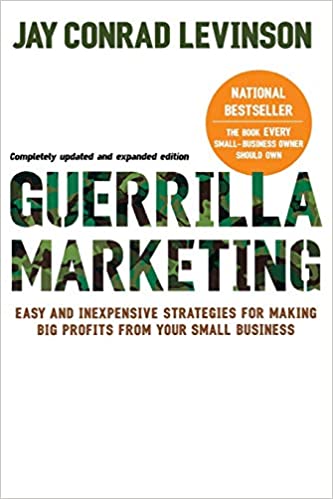According to Jay Levinson‘s definition, marketing is the art of getting people to change their minds or to maintain their mindsets if they are already inclined to do business with you. At the same time, the author believes that marketing is also a business, and the business is aimed at making a profit.
Jay Levinson introduced a new concept in marketing – guerrilla marketing. The concept of guerrilla marketing means using non-traditional marketing tools with limited financial or other resources. Guerrilla marketing is based on knowledge of psychology, and this makes it extremely effective because most purchases are made unconsciously. Properly organized customer support and human marketing tools strengthen the loyalty of old customers and attract new ones.
The author in his book “Guerilla Marketing: Easy and Inexpensive Strategies for Making Big Profits from Your Small Business” offers 20 differences between guerrilla marketing and traditional.
Differences between guerrilla and traditional marketing
1. In accordance with traditional marketing, companies need a large investment of money to enter the market and gain a foothold in it. Guerilla marketing recognizes the importance of money investment but prefers other resources: time, energy, imagination, and information.
2. Traditional marketing is not very clear for many entrepreneurs. They still do not understand what this definition means. Guerrilla marketing is a fully managed and controlled process.
3. Traditional marketing is focused on big business, while guerrilla marketing is a small business with a limited budget but huge ambitions.
4. Traditional marketing has a lot of efficiency criteria: sales volumes, the number of responses to an offer, clicks on websites. Guerrilla marketing has one efficiency indicator — the amount of your profit.
5. Traditional marketing is based on experience and judgment, and guerrilla marketing is based on the laws of human behavior – psychology.
6. Traditional marketing gradually develops the business, modifying it along the way, guerrilla marketing implies that you develop your business only if its growth is what you want.
7. According to the traditional marketing scheme, the business is growing linearly, gradually attracting new customers. Guerrilla marketing provides business growth in geometric progression.
8. Traditional marketing is aimed solely at selling a product or service and assumes that this is the end of marketing. Guerrilla marketing is aimed at maintaining a relationship with the customer.
9. Traditional marketing encourages you to study the market and eliminate competitors, and guerrilla marketing advises you to study the market to identify companies with similar goals and join forces with them, which will lead to lower costs. Guerrilla marketers call this approach – fusion marketing.
10. Traditional marketing believes that a logo is necessary to represent the company, and guerrilla marketing offers memes – universal visual and verbal symbols that convey the idea.

11. Traditional marketing is “me”-marketing with stories about the company, its goals, and its products. Guerrilla marketing is “you”-marketing, initially aimed at the desires and needs of customers.
12. Traditional marketing focuses on what can be obtained from the customer, while guerrilla marketing determines what can be given to the customer.
13. Traditional marketing believes in individual marketing tools (advertising, website, direct mail, and email), and guerrilla marketing believes that the right marketing combinations of these tools work.
14. Traditional marketing supporters count money, and guerrilla marketers collect new contacts that are the key to making a profit.
15. Traditional marketing has rarely focused on new technologies, mainly because of their expensive cost, and guerrilla marketers believe that the introduction of new technologies provides business agility and speed.
16. Traditional marketing is aimed at the broad masses; the goal of guerrilla marketing is to get its message to an individual.
17. Traditional marketing is global. It uses radio, television, and the press, but ignores the details. Guerilla marketing is detail-oriented, which helps build a reputation and retain customers.
18. The main goal of traditional marketing is to sell, but guerrilla marketing has a more realistic goal — to get people to agree to inform you about your product.
19. Traditional marketing is a monologue, and guerrilla marketing is a dialogue that makes a prospect a participant in the marketing process.
20. Traditional marketing recognizes only television, radio, newspapers, magazines, the Internet, direct mail, while guerrilla marketing uses 200 marketing weapons, some of which are free.
Jay Levinson lists sixteen secrets of guerrilla marketing
- Commitment. You must be committed to your marketing program.
- Investment. Think of that program as an investment.
- Consistent. The program must be consistent.
- Confident. Your prospect should be confident in your company.
- Patient. To be consistent, you will need patience.
- Assortment. You should consider marketing a wide range of different types of weapons.
- Subsequent. You must know that profits come after the sale.
- Convenient. You should strive to manage your company in a way that makes it more convenient for your clients.
- Amazement. Add an element of surprise to your marketing.
- Measurement. Calculate the effectiveness of your marketing.
- Involvement. Prove your involvement in the lives of your clients.
- Dependent. Learn to depend on other companies and let them depend on you.
- Armament. You must be able to handle guerrilla weapons-technology.
- Consent. Use marketing to get prospects to agree to further actions.
- Content. Sell the content of your offer, not its external features.
- Augment. Once your marketing program is fully ready, you should not stop there. It needs to be expanded.
According to guerrilla marketers, the marketing strategy consists of seven points
1. The goal of marketing is the action you want your prospect to take.
2. The way to achieve the goal – the competitive advantage and benefits of your product.
3. Your target market (or markets).
4. Your marketing weapons.
5. Your market niche, the position in the market that you occupy or are going to occupy.
6. The identity of your business – the uniqueness of your business.
7. Your budget to be expressed as a percentage of your projected gross revenues.
Jay Levinson divides marketing through media into the following categories

At the initial stage, the priority for guerrilla marketing is minimedia marketing. It doesn’t require significant financial investments, but it allows you to better study the target audience and ensure the speed and agility of the business.
Jay Levinson refers to minimedia marketing as the following types: collecting orders, sending personal letters, sending postcards, telemarketing, distributing leaflets and brochures, signboards, classified advertising, using “yellow pages”, business cards with a dual purpose.
Maximedia marketing includes newspapers, magazines, radio, television, outdoor advertising, direct mail, and the Internet. A guerrilla marketer should be able to use maximedia effectively with a small budget. Well-chosen maximedia tools can multiply the effect of minimedia.
Jay Levinson divides new-media marketing into 4 types

E-media marketing
The popularity of electronic marketing tools is growing every year. If you decide to engage in online sales, then you need to learn the three-thirds rule: you must determine the budget intended for online marketing, then invest a third of this amount in the development of your site, a third — in its promotion and a third — in its support.
The author gives instructions on Internet marketing:
– start with an outstanding product or service;
– create a motivating website;
– send emails with links to your site.
In Internet marketing, the author identifies the following effective tools: blogging, podcasting, nanocasting, email, your website, teleseminar, webinars, SEO. However, these Internet marketing tools are not very effective if you do not combine them with the means of mini – and maximedia.
Info-media marketing
Jay Levinson highlights another new type of media – informational. All the methods and tools that he puts in this category are aimed at transmitting information and, if applied correctly, leading to increased profits. It includes in this category: free consultations, free seminars, free demonstrations, marketing with treats, newsletters, electronic magazines (e-zine).
Human-media marketing
In this type of marketing, people play a leading role: you, your employees, satisfied customers, and media representatives. The author also includes in this category: partner programs, sales training. Providing high-quality service directly depends on the ability to hear the client.
By responding to their dreams and desires, you will earn gratitude and loyalty. Of the five most important reasons why people become regular customers of companies, the service comes in third place, just behind the trust and quality, but before the choice and price.
Nonmedia marketing
Nonmedia marketing is the most important method of a guerrilla marketer, since it does not require financial investments. However, it is no less important and requires an intangible investment in the form of time, energy, imagination, and information. In this category, the author includes public relations, industry exhibitions, fusion marketing, club memberships, word of mouth marketing, tenders, competitive advantages, guarantees.
At the end of the book, Jay Levinson lists 200 types of guerrilla marketing weapons.
The book “Guerrilla Marketing: Easy and Inexpensive Strategies for Making Big Profits from Your Small Business” will help you make sure that good marketing does not require large investments, will help you learn how to reduce marketing costs and will tell you about ideas for free promotion of products and services.
Read more marketing and sales Book Reviews in the special section of the website.





